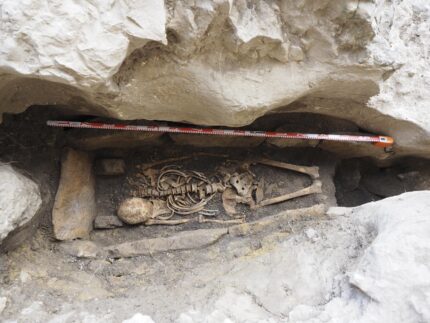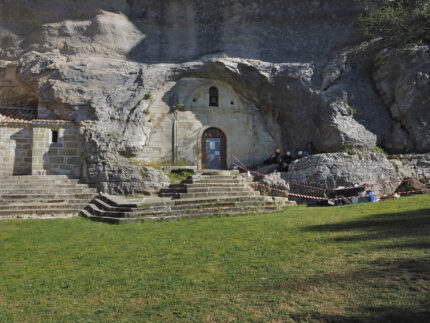Archaeologists have excavated a Hispano-Visigothic tomb in embedded in the rock next to the cave hermitage of San Tirso and San Bernabé in Burgos, northern Spain. A team from the Centro Nacional de Investigación sobre la Evolución Humana (CENIEH) unearthed the skeletal remains of an adult in a limestone slab tomb that dates to the late 7th, early 8th century. This discovery pushes back the evidence of the site’s use for Christian worship by centuries.
The anthropological studies, especially the analyses of stable isotopes of hydrogen, carbon and strontium, together with the dating for the remains, offer us a glimpse into the life of this person, who could have been associated with the first hermits who sought a retreat in this idyllic setting where they could live in isolation, during centuries of great turbulence linked to the arrival of the Moors, just as was the case elsewhere close to the upper course of the River Ebro and its tributaries in the south of the province of Cantabria, the north of Burgos, Álava and La Rioja.
The hermitage was built into the caves of the karst complex of Ojo Guareña, a network of 400 caves and 70 miles of galleries eroded out of the rock by the Trema and Guareña rivers. Humans have left their marks on the caves since the Middle Paleolithic. The earliest evidence of human usage are lithic from flint knapping about 70,000 years ago. There is cave art created as far back as 10,000 years through the beginning of the Bronze Age.
The cave chapel that is now dedicated to Christian saints Tirso and Bernabé was built at the site of a much earlier pagan sanctuary. The dates of construction are unknown. The first hermitage was dedicated to Saint Tirso, possibly as early as the 9th century, more likely the 13th. By the 18th century the hermitage was dedicated to a second saint, Bernabé, and between 1705 and 1877, the natural vaulted ceiling of the cave was painted with brightly colored murals depicting the miracles and martydoms of the saints.
Once the excavation has concluded and the human remains have been recovered, these will be consolidated and restored at the CENIEH. They will subsequently be subjected to dating, morphometric and paleopathological studies, while Ana Belén Marín and Borja González, researchers from the EvoAdapta R+D+i Group at the Universidad de Cantabria, will participate in isotopic studies.


Indeed, the Visigoths were essential to preaching the Gospel during the collapse of the Roman Empire. I am always curious if the analysis of the remains can explain the missing bits, (lower legs and hands), and the misplaced skull. Was this saint beheaded? Thanks again, you must have awesome sources for all this content on the blog!
Maybe, with a little help of the Franks, Emily:
The Roman Empire had collapsed a few centuries earlier, and in addition to all that, back then, due to what is referred here benevolently as “great turbulence linked to the arrival of the Moors”, their “gospel” was maybe not so sure.
Abd al-Rahman, the governor of “Al-Andalus”, unsuccessfully fought against Franks under Charles Martel in the Battle of Tours in 732 AD. Al-Rahman’s son attempted another attack on Gaul in 736. Then, in 752, the new King Pepin, son of Charles, led a campaign into Septimania, when regional Gothic allegiances were shifting in favour of the Frankish king.
Finally, Martel’s grandson Charlemagne created a barrier state between the Umayyad Emirate and Francia, the “Marca Hispanica”, basis for the Spanish Reconquista. In 802 AD, nonetheless, the elephant “Abul-Abbas” was brought to Aachen by Isaac the Jew as gift from caliph Harun al-Rashid. “Abul-Abbas” later collapsed in a campaign against invading Danes.
According to the ‘Frankish Annals’ for 810 AD, already after crossing the Rhine at “Lippeham”:
——-
“…Imperator vero Aquisgrani adhuc agens et contra Godofridum regem expeditionem meditans nuntium accepit […], deinde transmisso Rheno flumine in loco, qui Lippeham vocatur, […] elefans ille, quem ei Aaron rex Sarracenorum miserat, subita morte periit” :ohnoes:
——-